unit 4 Body language 教学设计
文档属性
| 名称 | unit 4 Body language 教学设计 | 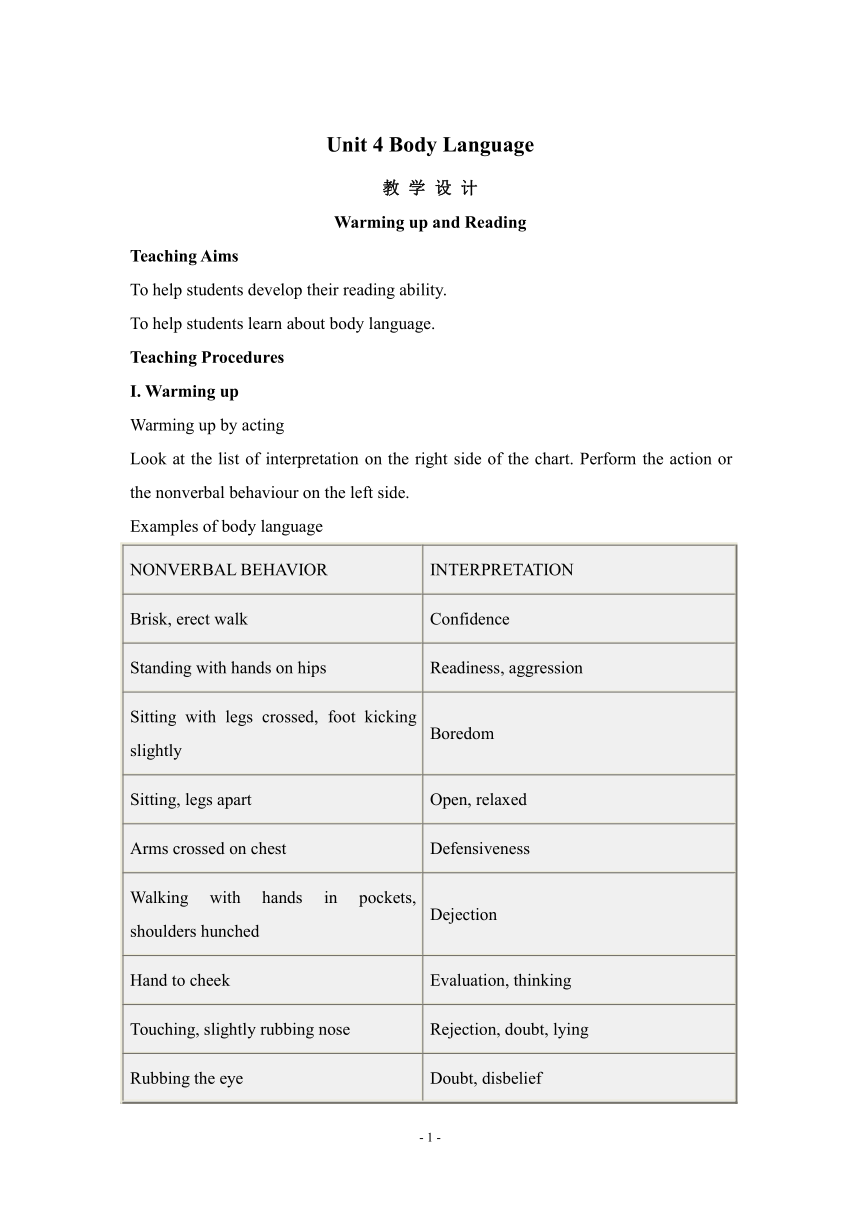 | |
| 格式 | zip | ||
| 文件大小 | 4.2MB | ||
| 资源类型 | 教案 | ||
| 版本资源 | 人教版(新课程标准) | ||
| 科目 | 英语 | ||
| 更新时间 | 2019-11-11 21:45:34 | ||
图片预览

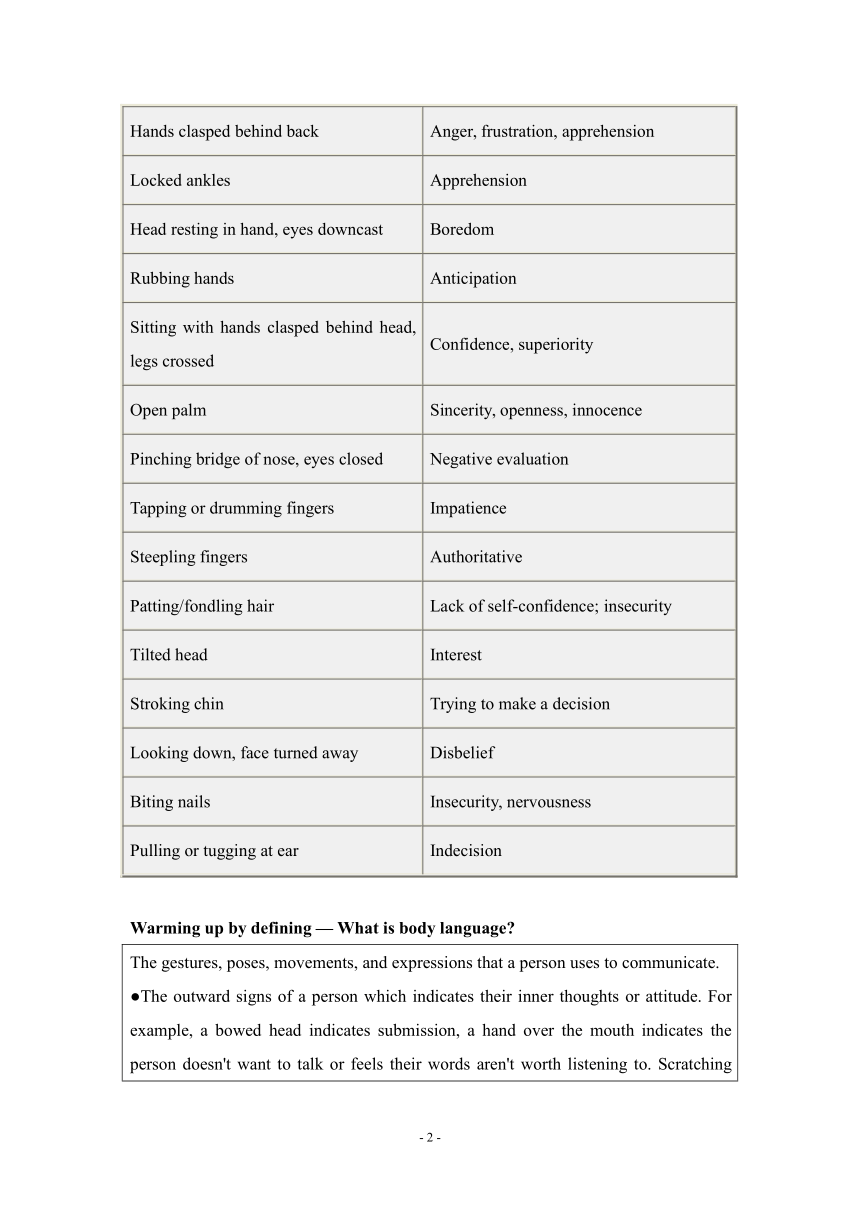
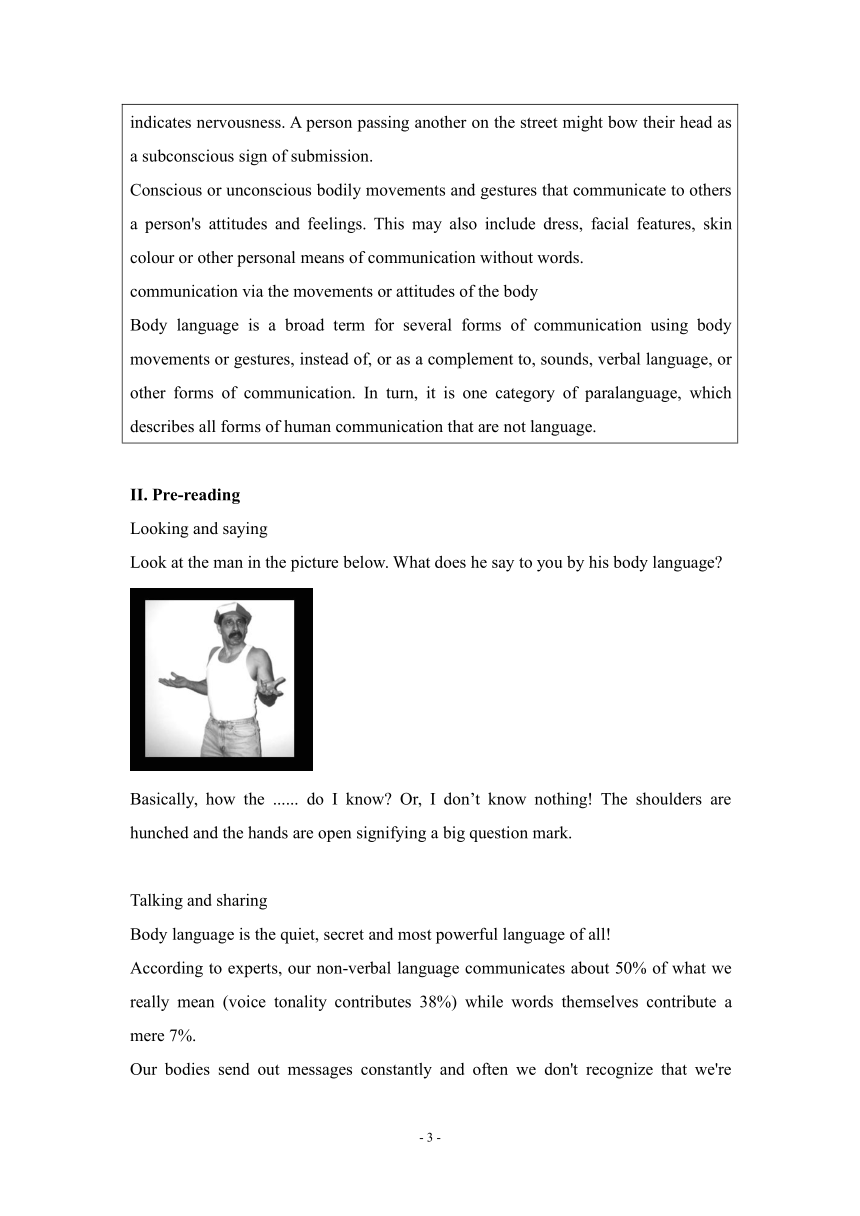
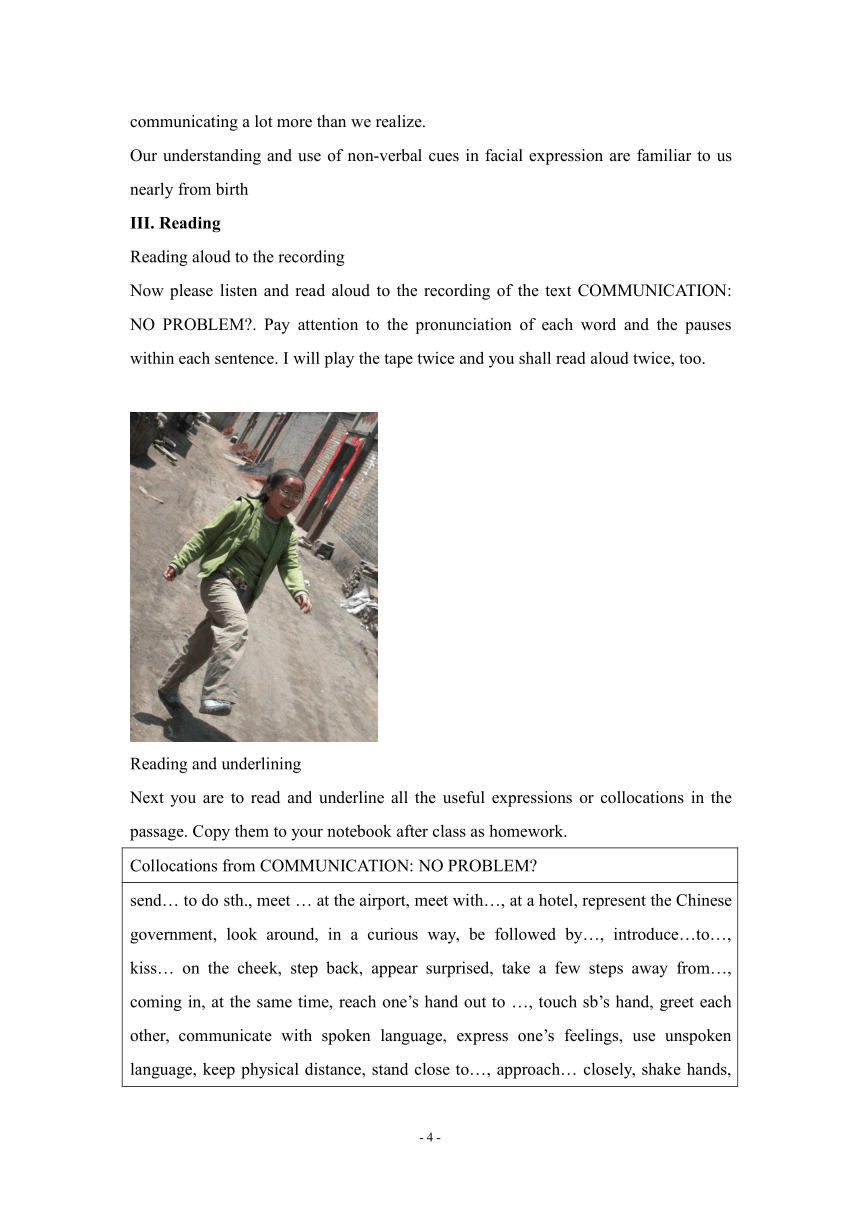
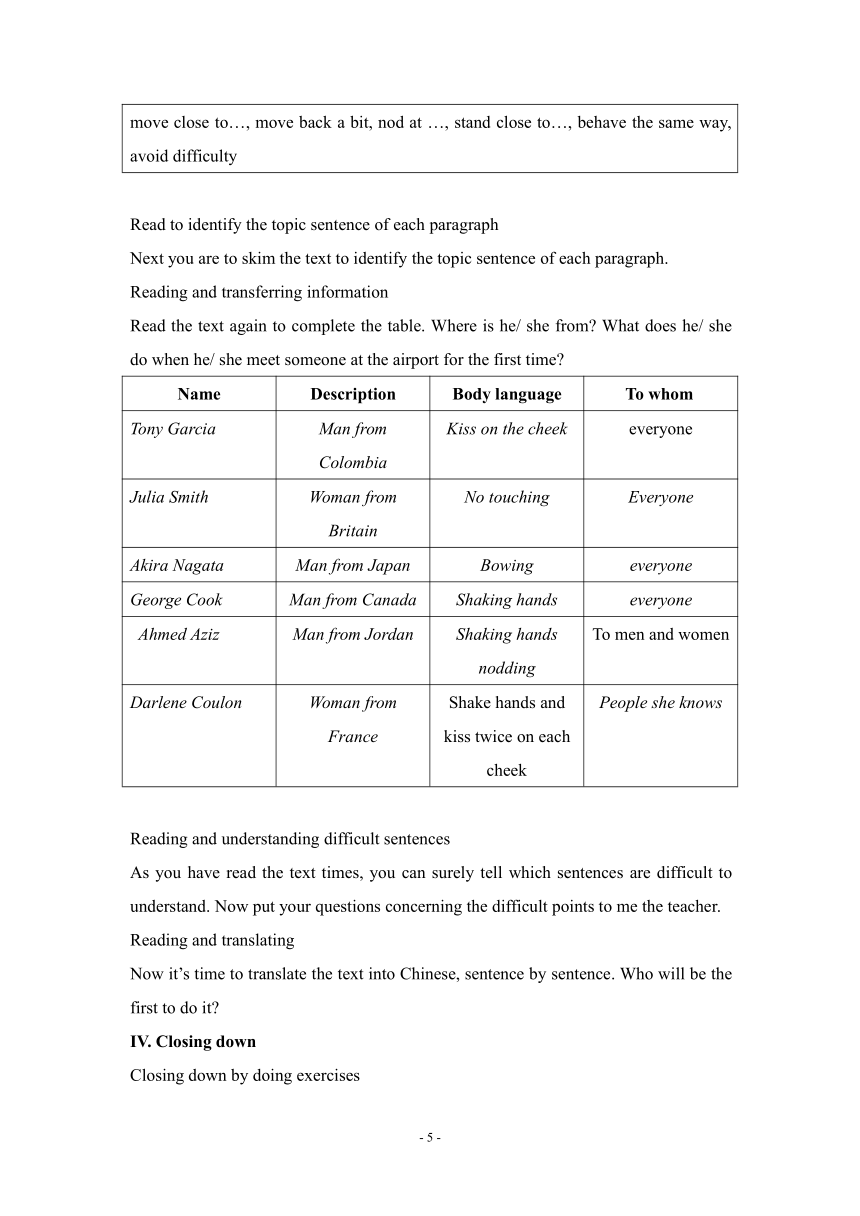
文档简介
Unit 4 Body Language
教 学 设 计
Warming up and Reading
Teaching Aims
To help students develop their reading ability.
To help students learn about body language.
Teaching Procedures
I. Warming up
Warming up by acting
Look at the list of interpretation on the right side of the chart. Perform the action or the nonverbal behaviour on the left side.
Examples of body language
NONVERBAL BEHAVIOR INTERPRETATION
Brisk, erect walk Confidence
Standing with hands on hips Readiness, aggression
Sitting with legs crossed, foot kicking slightly Boredom
Sitting, legs apart Open, relaxed
Arms crossed on chest Defensiveness
Walking with hands in pockets, shoulders hunched Dejection
Hand to cheek Evaluation, thinking
Touching, slightly rubbing nose Rejection, doubt, lying
Rubbing the eye Doubt, disbelief
Hands clasped behind back Anger, frustration, apprehension
Locked ankles Apprehension
Head resting in hand, eyes downcast Boredom
Rubbing hands Anticipation
Sitting with hands clasped behind head, legs crossed Confidence, superiority
Open palm Sincerity, openness, innocence
Pinching bridge of nose, eyes closed Negative evaluation
Tapping or drumming fingers Impatience
Steepling fingers Authoritative
Patting/fondling hair Lack of self-confidence; insecurity
Tilted head Interest
Stroking chin Trying to make a decision
Looking down, face turned away Disbelief
Biting nails Insecurity, nervousness
Pulling or tugging at ear Indecision
Warming up by defining — What is body language?
The gestures, poses, movements, and expressions that a person uses to communicate.
●The outward signs of a person which indicates their inner thoughts or attitude. For example, a bowed head indicates submission, a hand over the mouth indicates the person doesn't want to talk or feels their words aren't worth listening to. Scratching indicates nervousness. A person passing another on the street might bow their head as a subconscious sign of submission. Conscious or unconscious bodily movements and gestures that communicate to others a person's attitudes and feelings. This may also include dress, facial features, skin colour or other personal means of communication without words. communication via the movements or attitudes of the body Body language is a broad term for several forms of communication using body movements or gestures, instead of, or as a complement to, sounds, verbal language, or other forms of communication. In turn, it is one category of paralanguage, which describes all forms of human communication that are not language.
II. Pre-reading
Looking and saying
Look at the man in the picture below. What does he say to you by his body language?
Basically, how the ...... do I know? Or, I don’t know nothing! The shoulders are hunched and the hands are open signifying a big question mark.
Talking and sharing
Body language is the quiet, secret and most powerful language of all!
According to experts, our non-verbal language communicates about 50% of what we really mean (voice tonality contributes 38%) while words themselves contribute a mere 7%.
Our bodies send out messages constantly and often we don't recognize that we're communicating a lot more than we realize.
Our understanding and use of non-verbal cues in facial expression are familiar to us nearly from birth
III. Reading
Reading aloud to the recording
Now please listen and read aloud to the recording of the text COMMUNICATION: NO PROBLEM?. Pay attention to the pronunciation of each word and the pauses within each sentence. I will play the tape twice and you shall read aloud twice, too.
Reading and underlining
Next you are to read and underline all the useful expressions or collocations in the passage. Copy them to your notebook after class as homework.
Collocations from COMMUNICATION: NO PROBLEM?
send… to do sth., meet … at the airport, meet with…, at a hotel, represent the Chinese government, look around, in a curious way, be followed by…, introduce…to…, kiss… on the cheek, step back, appear surprised, take a few steps away from…, coming in, at the same time, reach one’s hand out to …, touch sb’s hand, greet each other, communicate with spoken language, express one’s feelings, use unspoken language, keep physical distance, stand close to…, approach… closely, shake hands, move close to…, move back a bit, nod at …, stand close to…, behave the same way, avoid difficulty
Read to identify the topic sentence of each paragraph
Next you are to skim the text to identify the topic sentence of each paragraph.
Reading and transferring information
Read the text again to complete the table. Where is he/ she from? What does he/ she do when he/ she meet someone at the airport for the first time?
Name Description Body language To whom
Tony Garcia Man from Colombia Kiss on the cheek everyone
Julia Smith Woman from Britain No touching Everyone
Akira Nagata Man from Japan Bowing everyone
George Cook Man from Canada Shaking hands everyone
Ahmed Aziz Man from Jordan Shaking hands nodding To men and women
Darlene Coulon Woman from France Shake hands and kiss twice on each cheek People she knows
Reading and understanding difficult sentences
As you have read the text times, you can surely tell which sentences are difficult to understand. Now put your questions concerning the difficult points to me the teacher.
Reading and translating
Now it’s time to translate the text into Chinese, sentence by sentence. Who will be the first to do it?
IV. Closing down
Closing down by doing exercises
To end the lesson you are to do the comprehending exercises on page 27.
Closing down by checking
Check some of the following basic non-verbal cues and you'll recognize that you already speak and translate much of the language.
HYPERLINK "http://images.google.com/imgres?imgurl=http://www.995.ca/images/surprised.jpg&imgrefurl=http://www.freerepublic.com/focus/f-news/1331022/posts&h=178&w=152&sz=5&tbnid=NiJisSqYFFEJ:&tbnh=95&tbnw=81&start=1&prev=/images%3Fq%3Dsurprised%26hl%3Dzh-C INCLUDEPICTURE "http://images.google.com/images?q=tbn:NiJisSqYFFEJ:www.995.ca/images/surprised.jpg" \* MERGEFORMATINET “I’m surprised!” HYPERLINK "http://images.google.com/imgres?imgurl=http://www.finsveen.org/images/Shocked%2520NC.JPG&imgrefurl=http://www.finsveen.org/&h=270&w=215&sz=8&tbnid=_SLkkPDuZt8J:&tbnh=108&tbnw=86&start=2&prev=/images%3Fq%3Dshocked%26hl%3Dzh-CN%26lr%3D%26newwindo INCLUDEPICTURE "http://images.google.com/images?q=tbn:_SLkkPDuZt8J:www.finsveen.org/images/Shocked%2520NC.JPG" \* MERGEFORMATINET “I’m shocked!” HYPERLINK "http://images.google.com/imgres?imgurl=http://www.aire-rescue.com/sat/images/sad.jpg&imgrefurl=http://sarahkennedy.blogspot.com/2004_10_01_sarahkennedy_archive.html&h=470&w=350&sz=20&tbnid=jLcLUow8jpQJ:&tbnh=125&tbnw=93&start=14&prev=/images%3F INCLUDEPICTURE "http://images.google.com/images?q=tbn:jLcLUow8jpQJ:www.aire-rescue.com/sat/images/sad.jpg" \* MERGEFORMATINET “I’m sad!”
Learning about Language
(The ~ing form as the Attribute & Adverbial)
Teaching Aims
To help students learn about the ~ing form as the Attribute & Adverbial.
To help students discover and learn to use some useful words and expressions.
To help students discover and learn to use some useful structures.
Teaching Procedures
I. Warming up
Warming up by discovering useful words and expressions
Turn to page 28 and do exercises No. 1, 2 and 3 first. Check your answers against your classmates’.
II. Learning about grammar
Reading and thinking
Turn to page 26 and read with me the text of COMMUNICATION: NO PROBLEM? As you read along, pay attention to the uses of the ~ing form as the Attribute & Adverbial.
(They are visitors coming from several countries. 作定语
Four people enter looking around in a curious way. 作状语
This is an exciting experience for you. 作定语
You stand watching and listening. 作状语;……)
Doing exercises No. 1 and 2 on page 29
III. Ready used materials for the ~ing form as the Attribute & Adverbial
... When we use a verb in -ing form more like a verb or an adjective, it is usually a present participle:. Anthony is fishing. I have a boring teacher. In this lesson, we will look at the use of verbs in the ~ing form ...
The ~ing form 作定语
现在分词可以单独作定语,也可以构成合成词作定语,但在更多的情况下是分词短语作定语,包括限定性和非限定性(用逗号与其他部分分开),在意义上相当于一个定语从句。现在分词作定语通常带有主动意义和未完成意义。例如:
The man following was obviously in a hurry。(现在分词单独作定语)
They acted just like a conquering army。(现在分词单独作定语)
Do you know the man standing over there by the motor car?(分词短语作限定性定语。)
Last night, we caught a thief stealing John's bike.(分词短语作限定性定语)
?The name Nebraske comes from the Indian word “ebrathka”. meaning flat water.(分词短语作非限定性定语)
The ~ing form 作状语
现在分词作状语表示主语在进行一动作的同时所进行的另一动作,它对谓语动词起修饰或陪衬的作用。这时要注意现在分词与其逻辑主语在时态和意义上的统一。例如:
????Rushing out of the room, he has knocked down by a car.(作时间状语)
=When he rushed out of the room, he was knocked down by a car.
????Working harder, you will pass the entrance exam.(作条件状语)
????=If you work harder, you will pass the entrance exam.
????She sat at a window and read a book.(作伴随状语)
????=She sat at a window and read a book.
????Having won the championship, he was awarded a million dollars.(作原因状语)
????=Because he had won the championship, he was awarded a million dollars.
????Even if taking a taxi, I will still be late for the meeting.(作让步状语)
????=Even if I take a taxi, I will still be late for the meeting.
????The road is under construction, thus causing the delay.(作结果状语)
????=The road is under construction, and thus caused the delay.
????注意,当现在分词作让步状语时,一般放在句首,常常由although, though, even if ,unless等连词引入;作结果状语时,一般放在句末,前面可so, thus, hence。
IV. Closing down by doing a quiz
To end the period you are going to take a quiz on ~ing words.
~ING WORDS
Highlight all the words ending in '-ing'.
Make lists of all the different categories of '-ing' words; that is, their different functions in the sentence.
Examples of some of the different categories He's swimming. He's wearing a swimming suit. He likes swimming. Swimming is pleasant.
Rewrite each sentence without using the '-ing' form.
Is there a change in meaning? What is it?
Find sentences in the text which can be rewritten using an -ing form.
Is there any change in meaning? What is it?
IV. Homework
Finish exercises in workbook on page 64.
Using Language
Teaching Aims
To help students read the passage SHOWING OUR FEELINGS.
To help students to use the language by reading, listening, speaking and writing.
Teaching Procedures
I. Warming up
Read aloud to warm up: Let’s warm up by reading aloud to the recording of the text SHOWING OUR FEELINGS.
II. Guided reading
Reading and translating
Read the text SHOWING OUR FEELINGS and translate it into Chinese paragraph by paragraph. He Jing. You are to do paragraph 1, please. ….
Reading and underlining
Next you are to read and underline all the useful expressions or collocations in the passage. Copy them to your notebook after class as homework.
Collocations from SHOWING OUR FEELINGS
Show all kinds of feeling, turn one’s back to…, show anger, close one’s hand, shake… at…, a universal facial expression, put…at ease, hide feelings, lose face, nod the head up and down, look away from…, hold one’s arms across one’s chest, protest…from …, turn toward…, roll one’s eyes, show respect for…, use gestures, give a hug to sb., stand close to…, with…open, look directly at…, look sb. in the eye, tell the truth, be wrong about…
Doing exercises
Now you are going to do exercises 1 and 2 on pages 30-31 following the article.
The importance of body language
People can not live without each other, we are social beings. As soon as we are in contact with others we are communicating. For this we can make use of spoken and written language. In these ways we make the content of a message clear to each other. However we can also communicate without words. This kind of communication tells us something about the relationship between people. Often this is more important than getting the content of the message across. The communication about this non spoken communication, which tells us something about the relationship between people, is called Meta-Communication. Communicating about communication!
Writing
Turn to page 31. Make a list of three positive body language expressions and three negative body language expressions.
Non-verbal communication, or body language Refers to messaging without words In a personal spoken message According to Albert Mehrabian, in Psychology Today (1968), of the total message 7% is conveyed by the words 38% by the vocal tones, and 55% by facial and body expression Reading body language is an important skill
Listening, writing
Turn to page 31 and do the listening and writing exercises No. 1 and 2.
Positive gesture clusters - 1●Acceptance Hand to chest Open arms and hands Touching gestures Moving closer, one to another Preening Sitting on one leg (for female)
Positive gesture clusters - 2●Confidence Steepling (fingers touching like a church steeple) Hands behind back, authority position Back stiffened Hands in coat pockets with thumbs out Hands on lapels of coat ●Expectancy Rubbing palms Jingling money openly Crossed fingers Moving closer Positive gesture clusters - 3●Cooperation, readiness, openness Open hands Hands on hips Hands on mid-thigh while seated Sitting on edge of chair Arms spread, gripping edge of table or desk Moving closer Sprinter's position Hand-to-face gestures Positive gesture clusters - 4●Evaluation Hand-to-face gestures Head tilted Stroking chin Peering over glasses Taking glasses off, and cleaning Putting eye glass ear piece in mouth Pipe smoker gestures Getting up from table and walking around Putting hand to bridge of nose Positive gesture clusters - 5●Reassurance Touching Pinching flesh Chewing pen or pencil Rubbing over thumb Touching back of chair on entering room Biting finger nails Hands in pockets Positive gesture clusters - 6●Self-control Holding arm behind back Gripping wrist Locked ankles Clenched hands
Speaking and writing
Discuss Lin Pei’s behaviour with your partner. Then write some advice for Lin Pei.
- 13 -
教 学 设 计
Warming up and Reading
Teaching Aims
To help students develop their reading ability.
To help students learn about body language.
Teaching Procedures
I. Warming up
Warming up by acting
Look at the list of interpretation on the right side of the chart. Perform the action or the nonverbal behaviour on the left side.
Examples of body language
NONVERBAL BEHAVIOR INTERPRETATION
Brisk, erect walk Confidence
Standing with hands on hips Readiness, aggression
Sitting with legs crossed, foot kicking slightly Boredom
Sitting, legs apart Open, relaxed
Arms crossed on chest Defensiveness
Walking with hands in pockets, shoulders hunched Dejection
Hand to cheek Evaluation, thinking
Touching, slightly rubbing nose Rejection, doubt, lying
Rubbing the eye Doubt, disbelief
Hands clasped behind back Anger, frustration, apprehension
Locked ankles Apprehension
Head resting in hand, eyes downcast Boredom
Rubbing hands Anticipation
Sitting with hands clasped behind head, legs crossed Confidence, superiority
Open palm Sincerity, openness, innocence
Pinching bridge of nose, eyes closed Negative evaluation
Tapping or drumming fingers Impatience
Steepling fingers Authoritative
Patting/fondling hair Lack of self-confidence; insecurity
Tilted head Interest
Stroking chin Trying to make a decision
Looking down, face turned away Disbelief
Biting nails Insecurity, nervousness
Pulling or tugging at ear Indecision
Warming up by defining — What is body language?
The gestures, poses, movements, and expressions that a person uses to communicate.
●The outward signs of a person which indicates their inner thoughts or attitude. For example, a bowed head indicates submission, a hand over the mouth indicates the person doesn't want to talk or feels their words aren't worth listening to. Scratching indicates nervousness. A person passing another on the street might bow their head as a subconscious sign of submission. Conscious or unconscious bodily movements and gestures that communicate to others a person's attitudes and feelings. This may also include dress, facial features, skin colour or other personal means of communication without words. communication via the movements or attitudes of the body Body language is a broad term for several forms of communication using body movements or gestures, instead of, or as a complement to, sounds, verbal language, or other forms of communication. In turn, it is one category of paralanguage, which describes all forms of human communication that are not language.
II. Pre-reading
Looking and saying
Look at the man in the picture below. What does he say to you by his body language?
Basically, how the ...... do I know? Or, I don’t know nothing! The shoulders are hunched and the hands are open signifying a big question mark.
Talking and sharing
Body language is the quiet, secret and most powerful language of all!
According to experts, our non-verbal language communicates about 50% of what we really mean (voice tonality contributes 38%) while words themselves contribute a mere 7%.
Our bodies send out messages constantly and often we don't recognize that we're communicating a lot more than we realize.
Our understanding and use of non-verbal cues in facial expression are familiar to us nearly from birth
III. Reading
Reading aloud to the recording
Now please listen and read aloud to the recording of the text COMMUNICATION: NO PROBLEM?. Pay attention to the pronunciation of each word and the pauses within each sentence. I will play the tape twice and you shall read aloud twice, too.
Reading and underlining
Next you are to read and underline all the useful expressions or collocations in the passage. Copy them to your notebook after class as homework.
Collocations from COMMUNICATION: NO PROBLEM?
send… to do sth., meet … at the airport, meet with…, at a hotel, represent the Chinese government, look around, in a curious way, be followed by…, introduce…to…, kiss… on the cheek, step back, appear surprised, take a few steps away from…, coming in, at the same time, reach one’s hand out to …, touch sb’s hand, greet each other, communicate with spoken language, express one’s feelings, use unspoken language, keep physical distance, stand close to…, approach… closely, shake hands, move close to…, move back a bit, nod at …, stand close to…, behave the same way, avoid difficulty
Read to identify the topic sentence of each paragraph
Next you are to skim the text to identify the topic sentence of each paragraph.
Reading and transferring information
Read the text again to complete the table. Where is he/ she from? What does he/ she do when he/ she meet someone at the airport for the first time?
Name Description Body language To whom
Tony Garcia Man from Colombia Kiss on the cheek everyone
Julia Smith Woman from Britain No touching Everyone
Akira Nagata Man from Japan Bowing everyone
George Cook Man from Canada Shaking hands everyone
Ahmed Aziz Man from Jordan Shaking hands nodding To men and women
Darlene Coulon Woman from France Shake hands and kiss twice on each cheek People she knows
Reading and understanding difficult sentences
As you have read the text times, you can surely tell which sentences are difficult to understand. Now put your questions concerning the difficult points to me the teacher.
Reading and translating
Now it’s time to translate the text into Chinese, sentence by sentence. Who will be the first to do it?
IV. Closing down
Closing down by doing exercises
To end the lesson you are to do the comprehending exercises on page 27.
Closing down by checking
Check some of the following basic non-verbal cues and you'll recognize that you already speak and translate much of the language.
HYPERLINK "http://images.google.com/imgres?imgurl=http://www.995.ca/images/surprised.jpg&imgrefurl=http://www.freerepublic.com/focus/f-news/1331022/posts&h=178&w=152&sz=5&tbnid=NiJisSqYFFEJ:&tbnh=95&tbnw=81&start=1&prev=/images%3Fq%3Dsurprised%26hl%3Dzh-C INCLUDEPICTURE "http://images.google.com/images?q=tbn:NiJisSqYFFEJ:www.995.ca/images/surprised.jpg" \* MERGEFORMATINET “I’m surprised!” HYPERLINK "http://images.google.com/imgres?imgurl=http://www.finsveen.org/images/Shocked%2520NC.JPG&imgrefurl=http://www.finsveen.org/&h=270&w=215&sz=8&tbnid=_SLkkPDuZt8J:&tbnh=108&tbnw=86&start=2&prev=/images%3Fq%3Dshocked%26hl%3Dzh-CN%26lr%3D%26newwindo INCLUDEPICTURE "http://images.google.com/images?q=tbn:_SLkkPDuZt8J:www.finsveen.org/images/Shocked%2520NC.JPG" \* MERGEFORMATINET “I’m shocked!” HYPERLINK "http://images.google.com/imgres?imgurl=http://www.aire-rescue.com/sat/images/sad.jpg&imgrefurl=http://sarahkennedy.blogspot.com/2004_10_01_sarahkennedy_archive.html&h=470&w=350&sz=20&tbnid=jLcLUow8jpQJ:&tbnh=125&tbnw=93&start=14&prev=/images%3F INCLUDEPICTURE "http://images.google.com/images?q=tbn:jLcLUow8jpQJ:www.aire-rescue.com/sat/images/sad.jpg" \* MERGEFORMATINET “I’m sad!”
Learning about Language
(The ~ing form as the Attribute & Adverbial)
Teaching Aims
To help students learn about the ~ing form as the Attribute & Adverbial.
To help students discover and learn to use some useful words and expressions.
To help students discover and learn to use some useful structures.
Teaching Procedures
I. Warming up
Warming up by discovering useful words and expressions
Turn to page 28 and do exercises No. 1, 2 and 3 first. Check your answers against your classmates’.
II. Learning about grammar
Reading and thinking
Turn to page 26 and read with me the text of COMMUNICATION: NO PROBLEM? As you read along, pay attention to the uses of the ~ing form as the Attribute & Adverbial.
(They are visitors coming from several countries. 作定语
Four people enter looking around in a curious way. 作状语
This is an exciting experience for you. 作定语
You stand watching and listening. 作状语;……)
Doing exercises No. 1 and 2 on page 29
III. Ready used materials for the ~ing form as the Attribute & Adverbial
... When we use a verb in -ing form more like a verb or an adjective, it is usually a present participle:. Anthony is fishing. I have a boring teacher. In this lesson, we will look at the use of verbs in the ~ing form ...
The ~ing form 作定语
现在分词可以单独作定语,也可以构成合成词作定语,但在更多的情况下是分词短语作定语,包括限定性和非限定性(用逗号与其他部分分开),在意义上相当于一个定语从句。现在分词作定语通常带有主动意义和未完成意义。例如:
The man following was obviously in a hurry。(现在分词单独作定语)
They acted just like a conquering army。(现在分词单独作定语)
Do you know the man standing over there by the motor car?(分词短语作限定性定语。)
Last night, we caught a thief stealing John's bike.(分词短语作限定性定语)
?The name Nebraske comes from the Indian word “ebrathka”. meaning flat water.(分词短语作非限定性定语)
The ~ing form 作状语
现在分词作状语表示主语在进行一动作的同时所进行的另一动作,它对谓语动词起修饰或陪衬的作用。这时要注意现在分词与其逻辑主语在时态和意义上的统一。例如:
????Rushing out of the room, he has knocked down by a car.(作时间状语)
=When he rushed out of the room, he was knocked down by a car.
????Working harder, you will pass the entrance exam.(作条件状语)
????=If you work harder, you will pass the entrance exam.
????She sat at a window and read a book.(作伴随状语)
????=She sat at a window and read a book.
????Having won the championship, he was awarded a million dollars.(作原因状语)
????=Because he had won the championship, he was awarded a million dollars.
????Even if taking a taxi, I will still be late for the meeting.(作让步状语)
????=Even if I take a taxi, I will still be late for the meeting.
????The road is under construction, thus causing the delay.(作结果状语)
????=The road is under construction, and thus caused the delay.
????注意,当现在分词作让步状语时,一般放在句首,常常由although, though, even if ,unless等连词引入;作结果状语时,一般放在句末,前面可so, thus, hence。
IV. Closing down by doing a quiz
To end the period you are going to take a quiz on ~ing words.
~ING WORDS
Highlight all the words ending in '-ing'.
Make lists of all the different categories of '-ing' words; that is, their different functions in the sentence.
Examples of some of the different categories He's swimming. He's wearing a swimming suit. He likes swimming. Swimming is pleasant.
Rewrite each sentence without using the '-ing' form.
Is there a change in meaning? What is it?
Find sentences in the text which can be rewritten using an -ing form.
Is there any change in meaning? What is it?
IV. Homework
Finish exercises in workbook on page 64.
Using Language
Teaching Aims
To help students read the passage SHOWING OUR FEELINGS.
To help students to use the language by reading, listening, speaking and writing.
Teaching Procedures
I. Warming up
Read aloud to warm up: Let’s warm up by reading aloud to the recording of the text SHOWING OUR FEELINGS.
II. Guided reading
Reading and translating
Read the text SHOWING OUR FEELINGS and translate it into Chinese paragraph by paragraph. He Jing. You are to do paragraph 1, please. ….
Reading and underlining
Next you are to read and underline all the useful expressions or collocations in the passage. Copy them to your notebook after class as homework.
Collocations from SHOWING OUR FEELINGS
Show all kinds of feeling, turn one’s back to…, show anger, close one’s hand, shake… at…, a universal facial expression, put…at ease, hide feelings, lose face, nod the head up and down, look away from…, hold one’s arms across one’s chest, protest…from …, turn toward…, roll one’s eyes, show respect for…, use gestures, give a hug to sb., stand close to…, with…open, look directly at…, look sb. in the eye, tell the truth, be wrong about…
Doing exercises
Now you are going to do exercises 1 and 2 on pages 30-31 following the article.
The importance of body language
People can not live without each other, we are social beings. As soon as we are in contact with others we are communicating. For this we can make use of spoken and written language. In these ways we make the content of a message clear to each other. However we can also communicate without words. This kind of communication tells us something about the relationship between people. Often this is more important than getting the content of the message across. The communication about this non spoken communication, which tells us something about the relationship between people, is called Meta-Communication. Communicating about communication!
Writing
Turn to page 31. Make a list of three positive body language expressions and three negative body language expressions.
Non-verbal communication, or body language Refers to messaging without words In a personal spoken message According to Albert Mehrabian, in Psychology Today (1968), of the total message 7% is conveyed by the words 38% by the vocal tones, and 55% by facial and body expression Reading body language is an important skill
Listening, writing
Turn to page 31 and do the listening and writing exercises No. 1 and 2.
Positive gesture clusters - 1●Acceptance Hand to chest Open arms and hands Touching gestures Moving closer, one to another Preening Sitting on one leg (for female)
Positive gesture clusters - 2●Confidence Steepling (fingers touching like a church steeple) Hands behind back, authority position Back stiffened Hands in coat pockets with thumbs out Hands on lapels of coat ●Expectancy Rubbing palms Jingling money openly Crossed fingers Moving closer Positive gesture clusters - 3●Cooperation, readiness, openness Open hands Hands on hips Hands on mid-thigh while seated Sitting on edge of chair Arms spread, gripping edge of table or desk Moving closer Sprinter's position Hand-to-face gestures Positive gesture clusters - 4●Evaluation Hand-to-face gestures Head tilted Stroking chin Peering over glasses Taking glasses off, and cleaning Putting eye glass ear piece in mouth Pipe smoker gestures Getting up from table and walking around Putting hand to bridge of nose Positive gesture clusters - 5●Reassurance Touching Pinching flesh Chewing pen or pencil Rubbing over thumb Touching back of chair on entering room Biting finger nails Hands in pockets Positive gesture clusters - 6●Self-control Holding arm behind back Gripping wrist Locked ankles Clenched hands
Speaking and writing
Discuss Lin Pei’s behaviour with your partner. Then write some advice for Lin Pei.
- 13 -
同课章节目录
